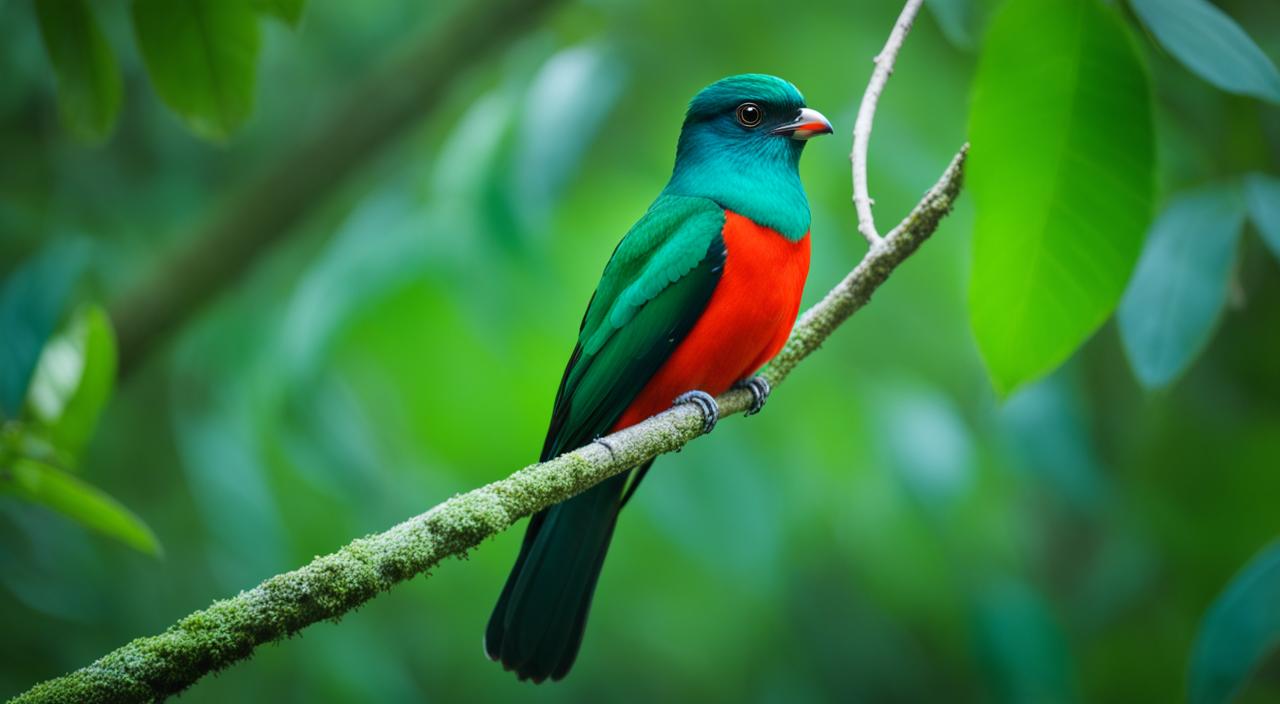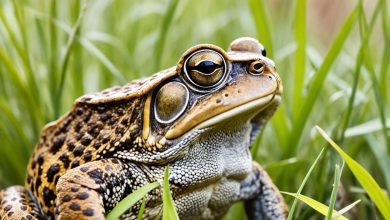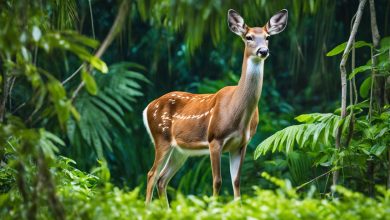Diard’s Trogon (Harpactes diardii) is a vibrant bird found in Southeast Asia’s forests. It was named after Pierre Médard Diard, a French naturalist. Diard’s Trogon is medium-sized, about 34 cm long, and shows clear differences between males and females.
The male Diard’s Trogon stands out with its pale blue bill, black chest, and scarlet belly. The female has a brown-red iris, a brown forehead, and a pale red belly. Sadly, it’s Near Threatened due to habitat loss and hunting.
Introduction to Diard’s Trogon
Diard’s Trogon is a bird that stands out with its bright colors and special way of finding food. It’s a favorite among bird lovers and scientists in Southeast Asia. This guide will cover everything about Diard’s Trogon, from its looks to its habits and how it lives.
There are 46 trogon species worldwide, and 7 live in the Malay Peninsula. Three of these species live in the highlands. Diard’s Trogon, or Harpactes diardi, is one of the most eye-catching in the area.
The male Diard’s Trogon has a bright red head and chest. This makes it easy to tell apart from other birds. The female doesn’t have the same pattern on its tail feathers, looking more like other birds.
Diard’s Trogon lives in the tropical and subtropical forests of Southeast Asia. You can find them in the Malay Peninsula, Sumatra, and Borneo. They love the highlands, living from 300 meters up to 2,600 meters high.
“Diard’s Trogon is a true gem of the Southeast Asian avifauna, captivating birdwatchers and nature enthusiasts with its vibrant plumage and unique behaviors.”
We’ll dive into the world of Diard’s Trogon, looking at its taxonomic details, looks, where it lives, and how it acts. This will give us a full picture of this amazing bird.
Diard’s Trogon
Taxonomy and Nomenclature
The Diard’s Trogon, known scientifically as Harpactes diardii, belongs to the Trogonidae family. It was first described by Coenraad Jacob Temminck in 1832. He named it after Pierre Médard Diard, a French naturalist. The species has two subspecies: Diard’s Trogon (H. d. diardii) and Sumatra Trogon (H. d. sumatranus).
Physical Description
Diard’s Trogon is a medium-sized bird, about 34 cm long. It shows clear differences in appearance between males and females. The male has a bright blue bill, black chest, and a bright red belly. The female looks different, with a brown-red iris and a pale red belly.
| Trait | Male Diard’s Trogon | Female Diard’s Trogon |
|---|---|---|
| Bill Color | Pale Blue | Brown-Red |
| Chest Color | Black | Brown |
| Belly Color | Scarlet | Pale Red |
| Iris Color | – | Brown-Red |
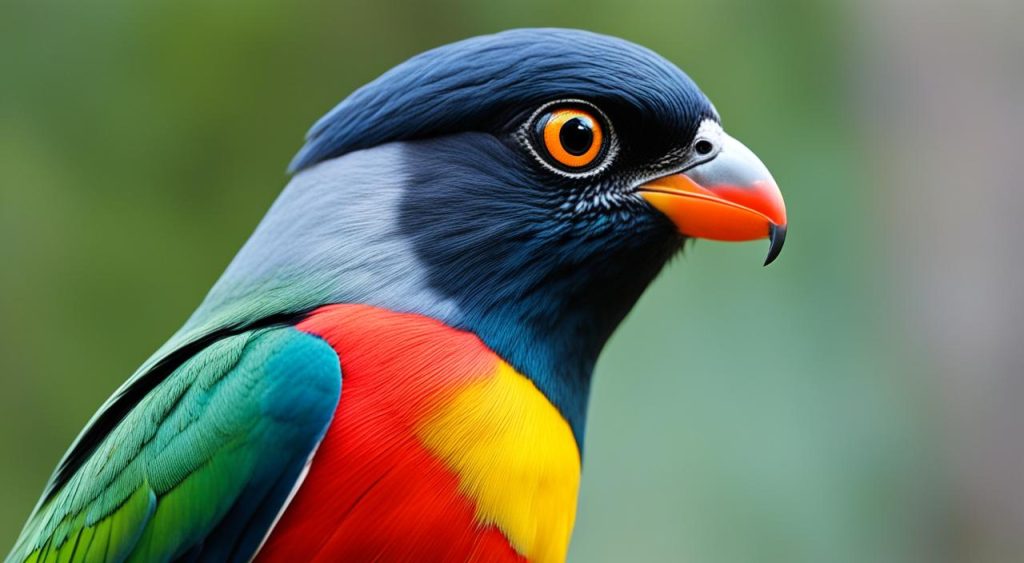
“The striking sexual dimorphism in the plumage of Diard’s Trogon is a defining feature of this beautiful bird species.”
Geographic Distribution and Habitat
Native Range
The diard’s trogon calls Southeast Asia home, living in the Malay Peninsula, Sumatra, and Borneo. It loves the tropical and subtropical moist broadleaf forests. These forests have dense undergrowth and tall trees.
Preferred Habitat
Diard’s trogon likes areas with both primary and secondary growth. It also enjoys places near streams and rivers. You can find it from sea level up to about 1,500 meters high.
This bird is a key part of the southeast asian bird habitats and malaysian forest bird locations. The harpactes diardi native range is in the rich, diard’s trogon habitat of Southeast Asia.
“Diard’s trogon is a true denizen of the tropical forests, adapted to thrive in the diverse and complex ecosystems of Southeast Asia.”
Behavior and Ecology
The Diard’s trogon, also known as the Harpactes diardi, is a bird that lives alone and guards its territory in Southeast Asia. It’s known for a loud, deep “kook-kook-kook” call that fills the forest.
These birds mostly live in trees, waiting to catch insects and small animals on the ground. They use a hunting method called “sallying” to do this. They don’t move much, staying in one place most of the time. This helps them control the insect and small animal populations in the forest.
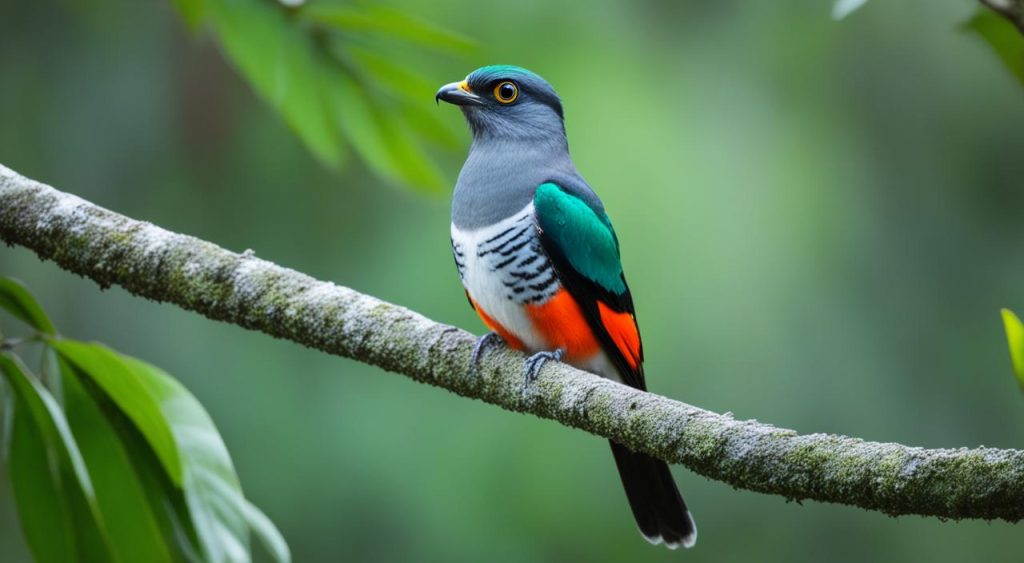
Studies show that Diard’s trogons are Near Threatened because their numbers are dropping fast. This is mainly because their home, the lowland forest, is being cut down in Southeast Asia. Conservationists are trying to save them by protecting their living areas and reducing forest fires and habitat loss.
“Diard’s trogons are fascinating birds, with their unique hunting techniques and distinctive calls that have captivated birdwatchers and naturalists alike. As we work to preserve their habitats, we hope to ensure the continued survival of this remarkable species.”
Researchers are studying the Diard’s trogon to learn how to protect it. They’re looking into what it needs to live, how it can live in different forests, and how many there are. This information will help make plans to save this Near Threatened bird in Southeast Asia.
Diet and Feeding Habits
Diard’s trogon (Harpactes diardi) eats a wide variety of foods. It includes insects, small lizards, frogs, and even small birds. This trogon species has special ways of finding food in Southeast Asia.
Food Sources
Diard’s trogon mainly eats insects like beetles, grasshoppers, and caterpillars. It also eats small vertebrates, including lizards, frogs, and small birds. Its flexible eating habits help it use the many food sources in its home area.
Foraging Techniques
- Diard’s trogon waits on a perch before swooping down to catch its prey in mid-air or on the ground.
- This “sally-glean” flight helps the trogon catch flying insects or small animals without using a lot of energy.
- It also uses a “sit-and-wait” method, staying still on a branch and then striking when prey comes close.
The Diard’s trogon’s flexible ways of finding food and its varied diet help it live well in Southeast Asia. It can be found in dense forests and open woodlands.
“Trogons are known for their unique foraging technique – a sally-glean flight.”
Breeding and Nesting
The Diard’s trogon, part of the Trogonidae family, has fascinating courtship and nesting habits. They form monogamous pairs during breeding season. The male’s courtship display includes amazing aerial tricks and sounds to win a mate.
After pairing, Diard’s trogons build their nest together. They use moss, leaves, and twigs to make a cozy home in a tree hole. The female trogon takes charge of incubating eggs. Both parents feed and care for the young.
Courtship and Mating
The Diard’s trogon’s courtship dance is truly a sight to see. The male performs daring dives and graceful swoops, all while making beautiful sounds. This show is to win a mate and start a monogamous relationship.
Nest Construction and Incubation
After finding a partner, Diard’s trogons build their nest together. They pick a tree hole and fill it with moss, leaves, and twigs. The female then keeps the eggs warm. Both parents feed and care for the baby birds.
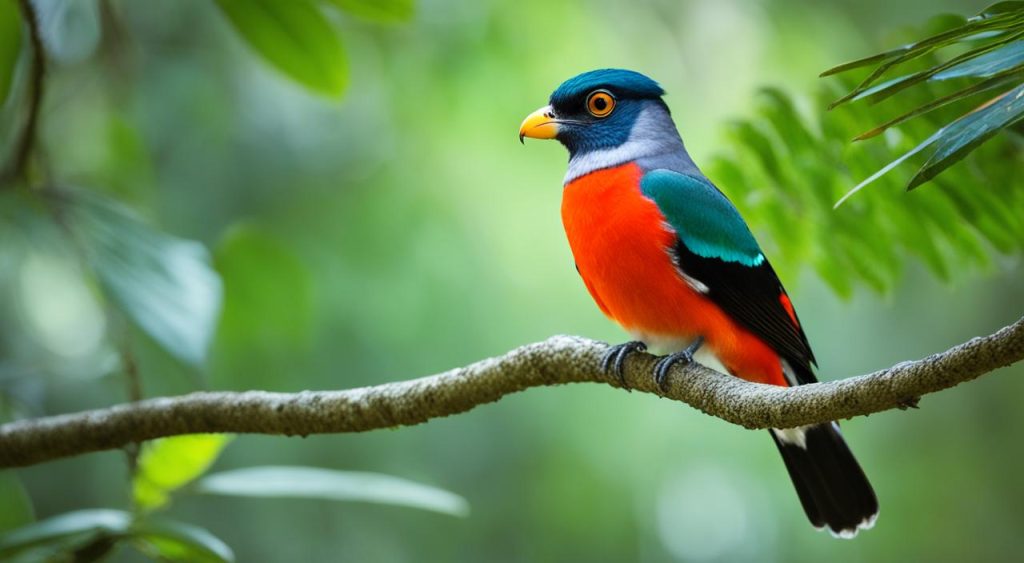
“Trogons are considered monogamous with both parents caring for their offspring.”
Conservation Status
The Diard’s trogon, a bird found in Southeast Asia’s forests, is listed as Near Threatened by the IUCN. This means we need to keep working to save this bird and its home.
Threats and Challenges
Habitat loss from deforestation, logging, and agriculture is a big threat. Hunting and the pet trade also harm these birds. These issues are making their numbers go down.
Within the Trogonidae family, some birds are Endangered, while others are Least Concern. Some species are stable, but others are getting fewer or more.
We must protect their homes, use forestry wisely, and stop poaching. These actions are key to saving the Diard’s trogon and other endangered birds in Southeast Asia. By tackling these issues, we can help these beautiful birds thrive for the future.
“Hearing the call of the Diard’s trogon is believed to be a bad omen by the Dayak Iban community in Southeast Asia, underscoring the cultural significance of this species.”
Interesting Facts about Diard’s Trogon
Diard’s trogon, also known as the Harpactes diardi, is a fascinating bird in Southeast Asia’s forests. It’s known for its white and black tail feathers. This makes it easy to spot in the wild.
The male Diard’s trogon has a bright cobalt blue bill and a scarlet belly. These colors make it a favorite among photographers and nature lovers. They want to capture its beauty in photos.
This bird is also known for its unique sounds and hunting ways. It uses a “perch-and-pounce” method to catch its food. This is perfect for its forest home.
| Trogon Species Trivia | Fact |
|---|---|
| Trogon Family | The order Trogoniformes contains only one family, Trogonidae, which comprises 39 species across eight genera. |
| Global Distribution | Trogons are primarily residents of tropical forests globally, with the most significant diversity found in the Neotropics, hosting four genera with 24 species. |
| Southeast Asian Trogons | The genera Harpactes and Apalharpactes have a combined total of twelve species found in southeast Asia. |
| Trogon Diet | These birds feed on insects and fruit, as indicated by their broad bills and weak legs which suit their diet and arboreal habits. |
| Trogon Flight Behavior | Although trogons have fast flight capabilities, they are inclined to fly short distances as they are primarily sedentary creatures. |
The Diard’s trogon is a gem of Southeast Asia’s bird world. It captivates birdwatchers and nature lovers with its unique traits and behaviors. As we learn more about birds, the Diard’s trogon shows us the amazing diversity and adaptations of trogon species.
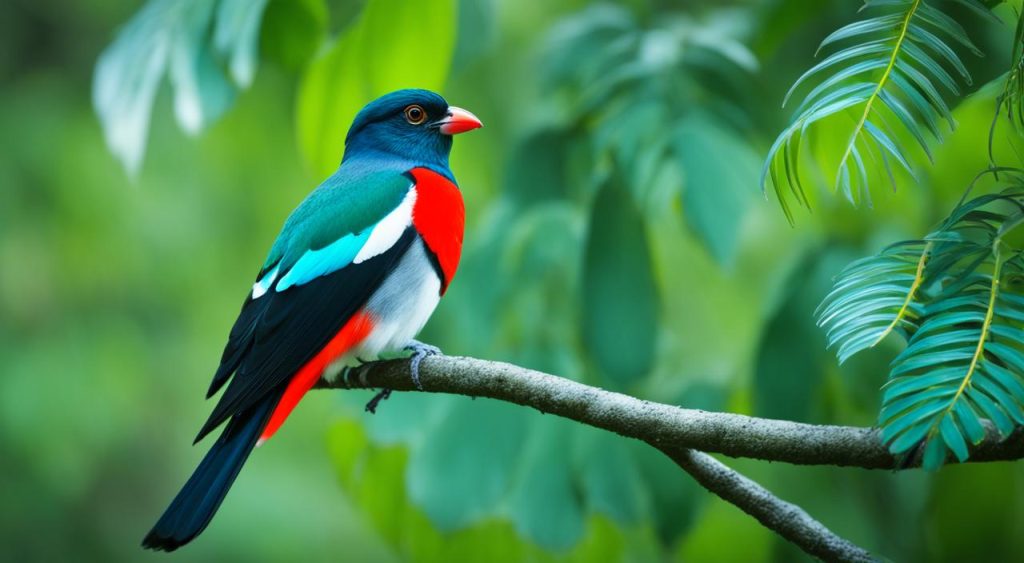
Diard’s Trogon in Aviculture
Diard’s Trogon, also known as the Harpactes diardi, is a beautiful bird from Southeast Asia. It has caught the eye of bird lovers. Yet, breeding these birds in captivity is tough due to the challenges of keeping them in zoos and homes.
One big issue is their diet. Diard’s Trogons eat insects, small fruits, and berries in the wild. In captivity, it’s hard to give them the right food, which needs a lot of work from experts.
These birds are also very sensitive to stress. This can make it hard for them to breed and stay healthy in captivity. Even so, some groups are trying to breed them in captivity to help the species. But most Diard’s Trogons live in the wild, where they need protected habitats to survive.
Some zoos and private collections have had success with breeding Diard’s Trogons. These successes are few but offer important lessons. They help us learn how to breed and care for these birds, which can aid in conservation efforts.
Conserving Southeast Asian birds, including the Diard’s Trogon, is very important. Researchers and conservationists are focusing on how to breed and manage these birds in captivity. They aim to help this unique trogon species thrive for the future.
“The challenges of maintaining Diard’s Trogons in captivity highlight the importance of protecting their natural habitats and populations in the wild.”
Diard’s Trogon Photography
Diard’s trogon is a colorful bird living in Southeast Asia’s forests. It’s a favorite among wildlife photographers. Taking great photos of this bird takes patience and skill. They are shy and hide in thick foliage.
This bird’s bright colors, like red, blue, and green, make it popular for photos. But, it lives in dense forests with changing light. You need special cameras and skills for trogon species photography.
Capturing Stunning Images
To get great photos of the Diard’s trogon, you need patience, skill, and the right gear. You must follow your subject quietly and know when to snap the photo. Understanding the bird’s habits and where it lives helps get amazing shots.
| Camera Settings | Recommended Techniques |
|---|---|
| High shutter speed (1/500s or faster) | Slow, steady approach to avoid startling the bird |
| Aperture between f/5.6 and f/8 | Use of camouflage and natural cover to blend in |
| High ISO (800-1600) | Patience and persistence to wait for the perfect moment |
With these tips and the right gear, photographers can take stunning diard’s trogon photos. These photos show off the bird’s beauty and unique traits.
Cultural Significance and Symbolism
Diard’s trogon, also known as the harpactes diardi, is not a big part of Southeast Asia’s cultural traditions. Yet, its unique look and link to the lush forests make it a symbol of the area’s natural beauty and rich biodiversity.
As more people learn about the threats to Diard’s trogon and its home, it might become a key symbol for conservation. It could inspire efforts to save Southeast Asia’s forests. Even though it’s not as culturally known as some other birds, its role in highlighting the need to protect biodiversity is growing.
On the other hand, other trogon species have a big role in myths and symbols of cultures. For instance, the scarlet-rumped trogon is seen as an omen bird by the Iban people in Malaysia. It’s linked to good luck and wealth. The Iban people deeply connect with nature, and their traditions often focus on birds.
| Omen Birds at the Iban Longhouse | Significance |
|---|---|
| Ketupong (Rufous Piculet) | Good omen for agriculture and crop yields |
| Beragai (Scarlet-rumped trogon) | Good luck and prosperity |
| Pangkas (Maroon Woodpecker) | Indication of a successful hunt |
| Bejampong (Crested Jay) | Signifies the arrival of important guests |
| Embuas (Banded Kingfisher) | Omen of good health and well-being |
| Kelabu Papau (Diard’s Trogon) | Not a prominent cultural symbol |
| Nendak (White-rumped shama) | Signifies a prosperous and harmonious community |
Diard’s trogon may not be as culturally significant as some birds in the region. But, it’s crucial in showing the need to protect Southeast Asia’s biodiversity. As threats to its home grow, the trogon could become more important as a symbol for conservation.
Observing Diard’s Trogon in the Wild
Birdwatchers and nature lovers who see Diard’s Trogon in the wild have a special treat. This bird’s bright colors, unique sounds, and behaviors are unforgettable. But finding and watching Diard’s Trogon is hard because it lives in deep, hard-to-get-to forests. You need patience, quietness, and help from local experts to see this beautiful bird.
The Rainforest Discovery Centre in Sepilok, near Sandakan, Malaysia, is a great spot to see Diard’s Trogon. It’s full of different birds like Broadbills and Hornbills. Visitors can walk the Belian, Kingfisher, and Pitta Path trails to see Diard’s Trogon and other special birds.
The Kabili-Sepilok Forest Reserve is perfect for a deep birding experience. Its tropical forests are where Diard’s Trogon loves to live. From the canopy walkways, you can see the birds up close. With expert guides, you’re more likely to see the Diard’s Trogon’s bright colors and how it behaves in the wild.
FAQ
What is Diard’s Trogon?
Diard’s Trogon is a colorful bird found in Southeast Asia’s forests. It’s named after Pierre Médard Diard, a French naturalist. It belongs to the Trogonidae family.
What are the physical characteristics of Diard’s Trogon?
This trogon is about 34 cm long and shows clear differences between males and females. Males have a bright blue bill, black chest, and a scarlet belly. Females have a brown-red iris, brown forehead, and a pale red belly.
Where is Diard’s Trogon found?
It lives in Southeast Asia’s forests, including the Malay Peninsula, Sumatra, and Borneo. You can find it in moist broadleaf forests with tall trees and dense undergrowth.
How does Diard’s Trogon behave and feed?
It’s a solitary bird that likes to stay in its territory. It spends most of its time in trees, catching insects in flight. It also hunts on the ground, using a unique swooping technique.
What is the conservation status of Diard’s Trogon?
The IUCN lists Diard’s Trogon as Near Threatened. It faces threats from deforestation, logging, and the pet trade. Hunting also harms its population.
What are some interesting facts about Diard’s Trogon?
It’s the only Harpactes trogon with white and black tail feathers. The male’s bright colors make it a favorite among birdwatchers and photographers.
Can Diard’s Trogon be observed in captivity?
Some zoos and private collections have tried to breed Diard’s Trogon. But, it’s hard to keep in captivity because of its special diet and stress sensitivity.
How can I observe Diard’s Trogon in the wild?
Seeing Diard’s Trogon in the wild is an adventure. You need patience, stealth, and expert guides to spot this rare and beautiful bird.
